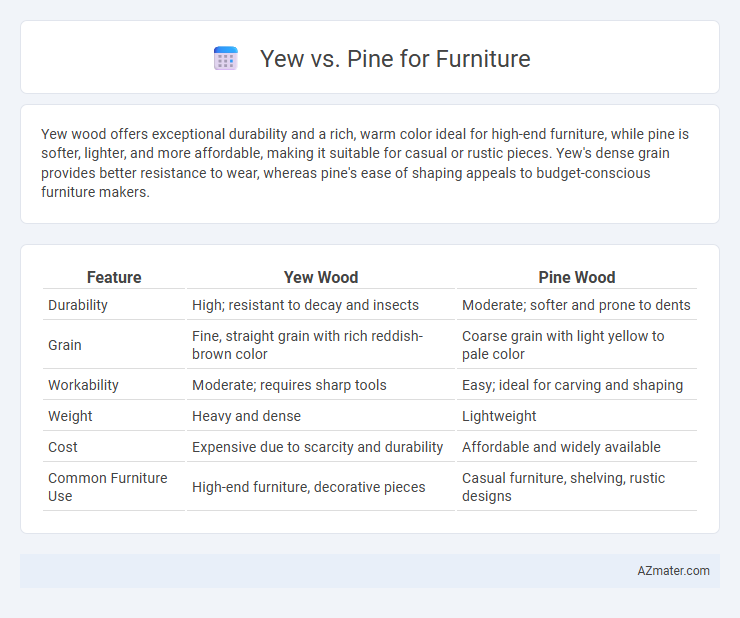Yew wood offers exceptional durability and a rich, warm color ideal for high-end furniture, while pine is softer, lighter, and more affordable, making it suitable for casual or rustic pieces. Yew's dense grain provides better resistance to wear, whereas pine's ease of shaping appeals to budget-conscious furniture makers.
Table of Comparison
| Feature | Yew Wood | Pine Wood |
|---|---|---|
| Durability | High; resistant to decay and insects | Moderate; softer and prone to dents |
| Grain | Fine, straight grain with rich reddish-brown color | Coarse grain with light yellow to pale color |
| Workability | Moderate; requires sharp tools | Easy; ideal for carving and shaping |
| Weight | Heavy and dense | Lightweight |
| Cost | Expensive due to scarcity and durability | Affordable and widely available |
| Common Furniture Use | High-end furniture, decorative pieces | Casual furniture, shelving, rustic designs |
Yew vs Pine: An Overview
Yew wood offers exceptional durability and a rich, reddish-brown hue, making it a premium choice for high-quality furniture, while pine is softer, lighter, and more affordable, favored for rustic and casual designs. Yew's tight grain and natural resistance to decay contrast with pine's more open grain and susceptibility to dents and scratches. Choosing between yew and pine depends on desired furniture longevity, appearance, and budget considerations.
Wood Grain and Appearance Comparison
Yew wood features a fine, straight grain with a smooth texture and rich reddish-brown hues that deepen over time, offering a luxurious and elegant appearance for furniture. Pine exhibits a more pronounced, knotty grain pattern with a lighter, yellowish tone that gives furniture a rustic, natural charm and a casual feel. The dense, tight grain of yew ensures durability and a polished finish, while pine's open grain creates a softer texture ideal for painted or distressed furniture designs.
Durability and Longevity
Yew wood offers excellent durability due to its dense grain and natural resistance to decay, making it ideal for high-quality, long-lasting furniture. Pine, although softer and less dense, provides moderate durability but may be more susceptible to dents and scratches over time. For longevity, Yew furniture generally outperforms Pine by maintaining structural integrity and appearance through years of use.
Workability and Ease of Crafting
Yew wood offers superior workability with a fine, straight grain that sands smoothly and holds intricate details, making it ideal for precision crafting in furniture. Pine, being softer and more porous, is easier to cut and shape quickly but may dent or scratch more readily during detailed work. Craftsmen often prefer yew for high-quality, durable furniture pieces requiring refined finishes, while pine suits projects benefiting from faster, less intricate assembly.
Environmental Impact and Sustainability
Yew wood offers exceptional durability and is sourced from slower-growing trees, which can lead to less frequent harvesting but requires responsible forest management to maintain sustainability. Pine grows faster and is more widely available, making it a more renewable option with a lower environmental footprint when sourced from certified plantations. Both woods have unique ecological impacts, but choosing FSC-certified Yew or Pine ensures reduced deforestation and supports sustainable forestry practices.
Cost Differences: Yew vs Pine
Yew furniture typically commands higher prices due to its dense grain, durability, and slower growth rate, which make the wood rarer and more valuable compared to pine. Pine is more affordable because it grows faster, is more abundant, and easier to work with, resulting in lower manufacturing costs. The cost difference between yew and pine furniture can range from 30% to 70%, depending on the quality and design complexity.
Suitability for Indoor and Outdoor Furniture
Yew wood is prized for its fine grain and natural resistance to decay, making it an excellent choice for both indoor and outdoor furniture, especially in dry climates. Pine offers a softer texture and affordability, but its susceptibility to moisture and insect damage limits its use primarily to indoor furniture unless properly treated. Both woods require appropriate finishes to enhance durability, with yew providing superior longevity and aesthetic appeal in outdoor settings.
Maintenance and Care Requirements
Yew wood requires moderate maintenance with regular dusting and occasional polishing to maintain its rich, reddish-brown hue and prevent surface drying. Pine furniture demands more diligent care due to its softness, often needing protective coatings and careful handling to avoid dents and scratches. Both woods benefit from controlled indoor humidity levels to prevent warping, with yew being slightly more resilient to environmental changes than pine.
Popular Furniture Styles for Each Wood
Yew wood is prized for its fine grain and rich reddish-brown hue, making it a popular choice in traditional and antique-style furniture such as classic cabinets, intricate carvings, and elegant turned pieces. Pine, known for its soft texture and pale color, is widely used in rustic, farmhouse, and Scandinavian furniture styles, offering versatility for tables, beds, and shelving with a cozy, casual aesthetic. The natural characteristics of yew lend themselves to detailed craftsmanship, while pine's affordability and ease of staining support a broad range of contemporary and country-inspired designs.
Final Verdict: Which Wood is Best for Your Furniture?
Yew offers a fine grain and rich color ideal for elegant, high-end furniture, while pine is softer, more affordable, and easier to work with, making it a popular choice for casual, rustic pieces. Yew's durability and resistance to wear suit heirloom or frequently used furniture, whereas pine's lighter weight and natural knots provide a charming, rustic aesthetic. Choosing between yew and pine depends on the desired furniture style, budget, and intended use, with yew favored for luxury and longevity, and pine preferred for cost-effectiveness and ease of customization.

Infographic: Yew vs Pine for Furniture
 azmater.com
azmater.com